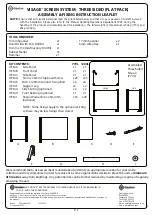
10
(4:3)
(16:9)
Figure 10
4:3 and 16:9 screen aspects
The projector can be connected to most video devices that can output video. You cannot directly
connect the coaxial cable that enters your house from cable TV or a satellite dish, as the signal
must pass through a tuner first. Examples of tuners are digital cable boxes, VCRs, digital video
recorders, and satellite TV boxes. Basically, any device that can change channels is considered a
tuner.
The next step is to identify the connector’s types the equipment you want to connect has. If there
is more than one output, select the highest quality one. Component video has the best quality,
followed by S-video, then composite video.
Here is a list of possible input signals and the connectors they should be connected to on the
projector
Input Signal
Connector
Connector label Source Name
On
Projector
on
Screen
Standard TV: satellite Composite Video
video 2
Video 2-Composite
TV, Digital or cable TV S-Video
video 1
Video 1-S-Video
(not HDTV)
Component Video
video 3
Video 3-Component
HDTV
Component
video
video
3
Video
3-Component
VGA
PC2
PC2-Analog
DVI
PC1
PC1-Analog
or
PC-1-Digital
DVD
Composite
video video
2
Video
2-Composite
S-video
video
1
Video
1-S-Video
Component
Video
video
3
Video
3-
Component
VCR
Composite
video video
2
Video
2-Composite
S-video
video
1
Video
1-S-Video
Video Camera
Composite video
video 2
Video 2-Composite
S-video
video
1
Video
1-S-Video
Video Game
Composite video
video 2
Video 2-Composite
S-video
video
1
Video
1-S-Video
16:9 image in
a 4:3 space
4:3 image
in a 16:9
space











































